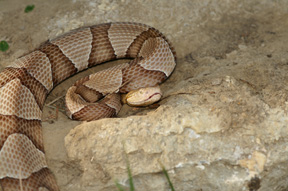|
|
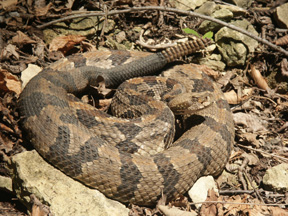 A timber rattlesnake from Gage County, Neb. Photo by Dan Fogell. |
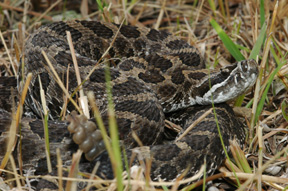 A massasauga rattlesnake from Pawnee County, Neb. Photo by Ted Leonard. |
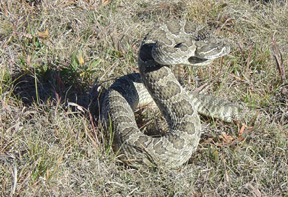 A prairie rattlesnake from Thomas County, Neb. Courtesy of Dennis Ferraro. |
Most U.S. physicians aren’t experts in non-native snakebites. These snakes are often foreign, unfamiliar and “exotic” and treating bites from cobras, and mambas and boomslangs is a challenge for anyone. Even bites by our native species — rattlesnakes, copperheads, cottonmouths, and coral snakes — can be very challenging cases.
“Because of recent advances in all areas of venomous snake and snakebite science, an international symposium is well-timed and well-located,” said Steven Seifert, M.D., medical director of the Nebraska Regional Poison Center, professor of medical toxicology at UNMC, a noted snakebite expert, and the organizer of “Snakebites in the New Millennium: A State-of-the-Art Symposium,” which will be Oct. 21-23 at UNMC.
Topics to be highlighted include recent advances in our understanding of the genetic development of venomous snakes and their venom, snakebite epidemiology, antivenom development, clinical management of snake envenomation, and improvements in our non-native snakebite response system. “We’re fortunate in Omaha to have the poison center, toxicologists with interest and expertise, the zoo, and terrific UNMC institutional support,” Dr. Seifert said.
Approximately 120 participants are expected at the three-day symposium, which will feature researchers and experts from 22 states and six countries, from as far away as Australia, South Africa, and Nepal. David Warrell, M.D., professor of tropical medicine at Oxford University (United Kingdom) and a world authority on tropical venomous snakes is the keynote speaker. There are more than 35 scientific presentations and events, such as a rattlesnake field trip to Gage County to see Nebraska’s native rattlesnakes in their natural environment and a behind-the-scenes tour of the collection of venomous non-native snakes in the Desert Dome at the Henry Doorly Zoo.
On Oct. 22, there also will be a dozen snakes – including rattlesnakes, a coral snake, and all four of Nebraska’s venomous indigenous snakes – on display at the symposium, which is targeted to emergency physicians, internists, family physicians, pediatricians, medical toxicologists, herpetologists, research scientists, zoo workers, veterinarians, and health science students.
“Snakebite envenomation is a major worldwide public health problem,” said UNMC oncologist James Armitage, M.D., who has a long-standing interest in snakes and helped organize the event. “Some suggest 100,000 or more are killed worldwide by snake envenomation every year. Steve (Seifert) is an expert on non-native snake envenomation and serves as a consultant to physicians across the country.”
In the United States, poison centers receive reports of approximately 3,000 native venomous snakebites a year, with an estimated incidence of up to 8,000 a year, Dr. Seifert said. U.S. poison centers also receive reports of more than 60 non-native snakebites a year. In the past 10 years, non-native venomous snakebites have involved more than 90 different species of snake — the largest group being cobras — and resulted in three deaths. This death rate is two to three times the death rate from envenomation by native species, which may be a result of barriers to locating and obtaining antivenom in a timely manner.
In addition to death, there is significant morbidity associated with snakebites, Dr. Seifert said, including blood-clotting abnormalities, permanent tissue injury, loss of function and loss of limb. “With many venomous snakebites, antivenom is the definitive treatment,” he said. “You want to administer it as soon as possible after envenomation. Delays in treatment can result in increased morbidity and an increased risk of death.”
That’s why the development of a new, Online Antivenom Index for use by poison centers and zoos is big news for health care providers. The new Online Antivenom Index, now in its final stages of testing, and expected to be online within the next few weeks, will provide a Web-accessible, interactive, and instantaneously updateable resource for responding to exotic snakebites nationwide.
“With an increasing incidence of non-native envenomations — 30 percent over the last four years — it’s becoming more likely that primary care providers will encounter a patient with a non-native snakebite,” said Dr. Seifert, a member of the development team. “We want physicians to know that a resource system exists and that access is through their regional poison centers, which can be reached by dialing 1-800-222-1222 anywhere in the country.”
This is the latest result of a series of collaborations between zoos and poison centers, including the development of guidelines for institutions housing venomous animals that were designed to prevent and improve local response to envenomations and the development of clinical management guidelines to assist physicians in providing care to victims of non-native envenomations.
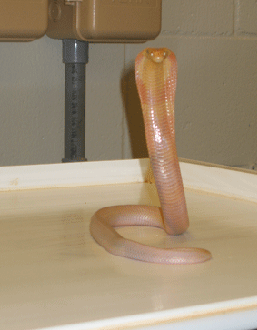 |
In the past 10 years, non-native venomous snakebites have involved more than 90 different species of snake — the largest group being cobras — and resulted in three deaths. This particular snake is an albino, monocellate cobra (Naja kaouthia) with origins from Asia. Courtesy of Steve Seifert, M.D. |
The new Online Antivenom Index will replace a joint publication of the American Zoo and Aquarium Association (AZA) and the American Association of Poison Control Centers (AAPCC) that was last published in print form in 1999 and “is sorely outdated,” Dr. Seifert said.
The new Online Antivenom Index was funded by a U.S. Department of Health and Human Services, Health Resources and Services Administration grant. The index will be accessible to the nation’s more than 5,500 AZA members and 61 regional poison centers. It will allow zoos to continuously maintain an up-to-date inventory of their antivenoms and allow poison centers to determine the appropriate antivenom for bites by exotic species, locate the closest source, assist in getting that antivenom to the treating physician, and provide additional information resources.
“With the new Online Antivenom Index, our nationwide system response will be enhanced with the potential to save tissue, to save function, and to save lives,” Dr. Seifert said.
Among the more than 25 symposium presenters:
- David Warrell, M.D., professor of tropical medicine and infectious disease at Oxford University, United Kingdom, an internationally-recognized authority on tropical snakes and snakebite, will address current standards of treatment worldwide, as well as issues in clinical trials;
- Leslie Boyer, M.D., medical director of the Arizona Poison & Drug Information Center in Tucson, Ariz., leads the Online Antivenom Index Development team and will update the symposium on the new system;
- Sean Bush, M.D., of Loma Linda University Medical Center and star of Animal Planet’s “Venom ER,” will present the severe end of the snakebite spectrum;
- Richard C. Dart, M.D., Ph.D., director of the Rocky Mountain Poison and Drug Center will discuss current controversies in rattlesnake bite management;
- Bryan Fry, Ph.D., deputy director of the University of Melbourne’s Venom Research Unit and winner of the Zuckerlandl Prize by the Journal of Molecular Evolution, will present his work on venom analysis and redefining our understanding of snake and venom genetic development;
- Dan Keyler, Pharm.D., of the Minneapolis Medical Research Foundation, will discuss the diversity of venomous snakes available to private collectors in the U.S.;
- Jessi Krebs, supervisor of amphibians and reptiles at Omaha’s Henry Doorly Zoo, will discuss procedures to reduce the incidence of snakebite at zoos; and
- Steven Seifert, M.D., will present a systematic characterization of non-native envenomations in the U.S. over the past decade.
Interesting facts
- Of the estimated 45,000 snakebites each year in the United States, up to 8,000 involve venomous species.
- In the past 10 years, non-native snakebite reports in the United States have involved more than 90 different species of snakes, resulting in three deaths.
- On average, non-native venomous snakes account for more than 60 bites each year in the United States, with 23 percent occurring in victims less than 20 years of age, and 14 percent under 12 years of age.
- The Nebraska Regional Poison Center, the designated poison center for Nebraska, Wyoming, American Samoa and Federated States of Micronesia, receives calls on up to 20 native snakebites and one to two non-native venomous snakebites a year.
- There are 29 species of snakes in Nebraska, including four venomous snakes: timber rattlesnake, prairie rattlesnake, copperhead and massasauga.
